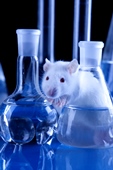Home > Press > New tests for determining health and environmental effects of nanomaterials
 |
| Scientific testing that doesn’t rely on animals will be needed to cope with the wave of new nanomaterials emerging from nanoscience and nanotechnology booms.
Credit: iStockphoto/Thinkstock |
Abstract:
A group of international experts from government, industry and academia have concluded that alternative testing strategies (ATSs) that don't rely on animals will be needed to cope with the wave of new nanomaterials emerging from the boom in nanoscience and nanotechnology. Their consensus statement from a workshop on the topic appears in the journal ACS Nano.
New tests for determining health and environmental effects of nanomaterials
Washington, DC | Posted on August 21st, 2013Andre Nel and colleagues explain that many new engineered nanomaterials (ENMs) are appearing in laboratories, factories and consumer products as a result of advances in nanoscience and nanotechnology. These fields involve materials so small that hundreds would fit inside the period at the end of this sentence, and they have properties much different from larger particles of the same material. Tests on laboratory mice, rats and other animals have been the standard way of checking new materials for health and environmental effects. Since those tests are costly, labor-intensive and time-consuming, workshop participants considered whether ATSs could have a larger role in checking the safety of ENMs.
They concluded that rapid cellular screening, computer modeling and other ATSs could serve as quick, cost-effective and reliable approaches for gathering certain types of information about the health and environmental effects of ENMs. "After lively discussions, a short list of generally shared viewpoints on this topic was generated, including a general view that ATS approaches for ENMs can significantly benefit chemical safety analysis," they say.
Funding was from the National Science Foundation, the U.S. Environmental Protection Agency, the National Institute of Environmental Health Sciences and non-federal sources.
####
About American Chemical Society
The American Chemical Society is a nonprofit organization chartered by the U.S. Congress. With more than 163,000 members, ACS is the world’s largest scientific society and a global leader in providing access to chemistry-related research through its multiple databases, peer-reviewed journals and scientific conferences. Its main offices are in Washington, D.C., and Columbus, Ohio.
For more information, please click here
Contacts:
Andre Nel, M.D., Ph.D.
Department of Medicine, Division of NanoMedicine
University of California Center for Environmental Implications of Nanotechnology
California NanoSystems Institute
Fielding School of Public Health
University of California, Los Angeles
Los Angeles, Calif. 90095
Science Inquiries:
Michael Woods
editor
202-872-6293
General Inquiries:
Michael Bernstein
202-872-6042
Copyright © American Chemical Society
If you have a comment, please Contact us.Issuers of news releases, not 7th Wave, Inc. or Nanotechnology Now, are solely responsible for the accuracy of the content.
| Related Links |
| Related News Press |
News and information
![]() Researchers develop molecular qubits that communicate at telecom frequencies October 3rd, 2025
Researchers develop molecular qubits that communicate at telecom frequencies October 3rd, 2025
![]() Next-generation quantum communication October 3rd, 2025
Next-generation quantum communication October 3rd, 2025
![]() "Nanoreactor" cage uses visible light for catalytic and ultra-selective cross-cycloadditions October 3rd, 2025
"Nanoreactor" cage uses visible light for catalytic and ultra-selective cross-cycloadditions October 3rd, 2025
Govt.-Legislation/Regulation/Funding/Policy
![]() New imaging approach transforms study of bacterial biofilms August 8th, 2025
New imaging approach transforms study of bacterial biofilms August 8th, 2025
![]() Electrifying results shed light on graphene foam as a potential material for lab grown cartilage June 6th, 2025
Electrifying results shed light on graphene foam as a potential material for lab grown cartilage June 6th, 2025
![]() Institute for Nanoscience hosts annual proposal planning meeting May 16th, 2025
Institute for Nanoscience hosts annual proposal planning meeting May 16th, 2025
Academic/Education
![]() Rice University launches Rice Synthetic Biology Institute to improve lives January 12th, 2024
Rice University launches Rice Synthetic Biology Institute to improve lives January 12th, 2024
![]() Multi-institution, $4.6 million NSF grant to fund nanotechnology training September 9th, 2022
Multi-institution, $4.6 million NSF grant to fund nanotechnology training September 9th, 2022
Announcements
![]() Rice membrane extracts lithium from brines with greater speed, less waste October 3rd, 2025
Rice membrane extracts lithium from brines with greater speed, less waste October 3rd, 2025
![]() Researchers develop molecular qubits that communicate at telecom frequencies October 3rd, 2025
Researchers develop molecular qubits that communicate at telecom frequencies October 3rd, 2025
![]() Next-generation quantum communication October 3rd, 2025
Next-generation quantum communication October 3rd, 2025
![]() "Nanoreactor" cage uses visible light for catalytic and ultra-selective cross-cycloadditions October 3rd, 2025
"Nanoreactor" cage uses visible light for catalytic and ultra-selective cross-cycloadditions October 3rd, 2025
Industrial
![]() Quantum interference in molecule-surface collisions February 28th, 2025
Quantum interference in molecule-surface collisions February 28th, 2025
![]() Boron nitride nanotube fibers get real: Rice lab creates first heat-tolerant, stable fibers from wet-spinning process June 24th, 2022
Boron nitride nanotube fibers get real: Rice lab creates first heat-tolerant, stable fibers from wet-spinning process June 24th, 2022
![]() Nanotubes: a promising solution for advanced rubber cables with 60% less conductive filler June 1st, 2022
Nanotubes: a promising solution for advanced rubber cables with 60% less conductive filler June 1st, 2022
Safety-Nanoparticles/Risk management
![]() Onion-like nanoparticles found in aircraft exhaust May 14th, 2025
Onion-like nanoparticles found in aircraft exhaust May 14th, 2025
![]() Closing the gaps — MXene-coating filters can enhance performance and reusability February 28th, 2025
Closing the gaps — MXene-coating filters can enhance performance and reusability February 28th, 2025
|
|
||
|
|
||
| The latest news from around the world, FREE | ||
|
|
||
|
|
||
| Premium Products | ||
|
|
||
|
Only the news you want to read!
Learn More |
||
|
|
||
|
Full-service, expert consulting
Learn More |
||
|
|
||








